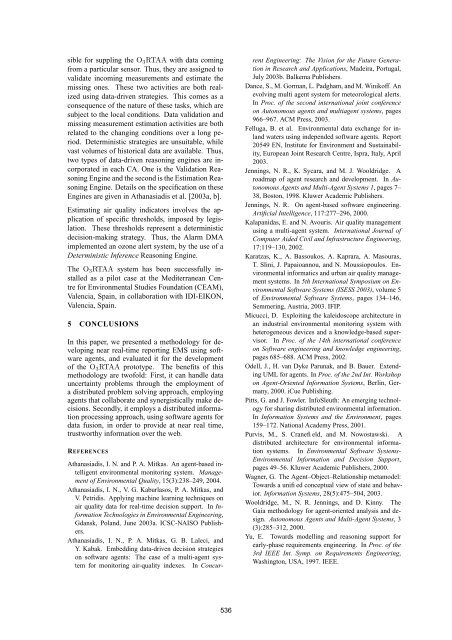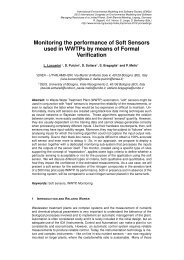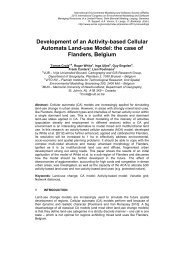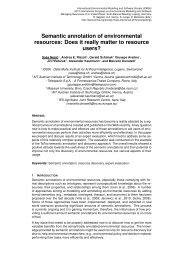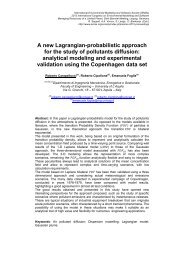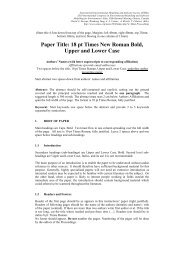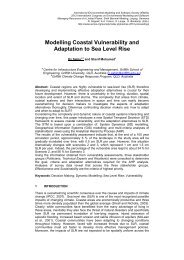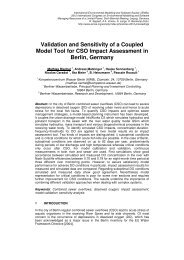Volume 2 - International Environmental Modelling and Software ...
Volume 2 - International Environmental Modelling and Software ...
Volume 2 - International Environmental Modelling and Software ...
You also want an ePaper? Increase the reach of your titles
YUMPU automatically turns print PDFs into web optimized ePapers that Google loves.
sible for suppling the O 3 RTAA with data coming<br />
from a particular sensor. Thus, they are assigned to<br />
validate incoming measurements <strong>and</strong> estimate the<br />
missing ones. These two activities are both realized<br />
using data-driven strategies. This comes as a<br />
consequence of the nature of these tasks, which are<br />
subject to the local conditions. Data validation <strong>and</strong><br />
missing measurement estimation activities are both<br />
related to the changing conditions over a long period.<br />
Deterministic strategies are unsuitable, while<br />
vast volumes of historical data are available. Thus,<br />
two types of data-driven reasoning engines are incorporated<br />
in each CA. One is the Validation Reasoning<br />
Engine <strong>and</strong> the second is the Estimation Reasoning<br />
Engine. Details on the specification on these<br />
Engines are given in Athanasiadis et al. [2003a, b].<br />
Estimating air quality indicators involves the application<br />
of specific thresholds, imposed by legislation.<br />
These thresholds represent a deterministic<br />
decision-making strategy. Thus, the Alarm DMA<br />
implemented an ozone alert system, by the use of a<br />
Deterministic Inference Reasoning Engine.<br />
The O 3 RTAA system has been successfully installed<br />
as a pilot case at the Mediterranean Centre<br />
for <strong>Environmental</strong> Studies Foundation (CEAM),<br />
Valencia, Spain, in collaboration with IDI-EIKON,<br />
Valencia, Spain.<br />
5 CONCLUSIONS<br />
In this paper, we presented a methodology for developing<br />
near real-time reporting EMS using software<br />
agents, <strong>and</strong> evaluated it for the development<br />
of the O 3 RTAA prototype. The benefits of this<br />
methodology are twofold: First, it can h<strong>and</strong>le data<br />
uncertainty problems through the employment of<br />
a distributed problem solving approach, employing<br />
agents that collaborate <strong>and</strong> synergistically make decisions.<br />
Secondly, it employs a distributed information<br />
processing approach, using software agents for<br />
data fusion, in order to provide at near real time,<br />
trustworthy information over the web.<br />
REFERENCES<br />
Athanasiadis, I. N. <strong>and</strong> P. A. Mitkas. An agent-based intelligent<br />
environmental monitoring system. Management<br />
of <strong>Environmental</strong> Quality, 15(3):238–249, 2004.<br />
Athanasiadis, I. N., V. G. Kaburlasos, P. A. Mitkas, <strong>and</strong><br />
V. Petridis. Applying machine learning techniques on<br />
air quality data for real-time decision support. In Information<br />
Technologies in <strong>Environmental</strong> Engineering,<br />
Gdansk, Pol<strong>and</strong>, June 2003a. ICSC-NAISO Publishers.<br />
Athanasiadis, I. N., P. A. Mitkas, G. B. Laleci, <strong>and</strong><br />
Y. Kabak. Embedding data-driven decision strategies<br />
on software agents: The case of a multi-agent system<br />
for monitoring air-quality indexes. In Concurrent<br />
Engineering: The Vision for the Future Generation<br />
in Research <strong>and</strong> Applications, Madeira, Portugal,<br />
July 2003b. Balkema Publishers.<br />
Dance, S., M. Gorman, L. Padgham, <strong>and</strong> M. Winikoff. An<br />
evolving multi agent system for meteorological alerts.<br />
In Proc. of the second international joint conference<br />
on Autonomous agents <strong>and</strong> multiagent systems, pages<br />
966–967. ACM Press, 2003.<br />
Felluga, B. et al. <strong>Environmental</strong> data exchange for inl<strong>and</strong><br />
waters using independed software agents. Report<br />
20549 EN, Institute for Environment <strong>and</strong> Sustainability,<br />
European Joint Research Centre, Ispra, Italy, April<br />
2003.<br />
Jennings, N. R., K. Sycara, <strong>and</strong> M. J. Wooldridge. A<br />
roadmap of agent research <strong>and</strong> development. In Autonomous<br />
Agents <strong>and</strong> Multi-Agent Systems 1, pages 7–<br />
38, Boston, 1998. Kluwer Academic Publishers.<br />
Jennings, N. R. On agent-based software engineering.<br />
Artificial Intelligence, 117:277–296, 2000.<br />
Kalapanidas, E. <strong>and</strong> N. Avouris. Air quality management<br />
using a multi-agent system. <strong>International</strong> Journal of<br />
Computer Aided Civil <strong>and</strong> Infrastructure Engineering,<br />
17:119–130, 2002.<br />
Karatzas, K., A. Bassoukos, A. Kaprara, A. Masouras,<br />
T. Slini, J. Papaioannou, <strong>and</strong> N. Moussiopoulos. <strong>Environmental</strong><br />
informatics <strong>and</strong> urban air quality management<br />
systems. In 5th <strong>International</strong> Symposium on <strong>Environmental</strong><br />
<strong>Software</strong> Systems (ISESS 2003), volume 5<br />
of <strong>Environmental</strong> <strong>Software</strong> Systems, pages 134–146,<br />
Semmering, Austria, 2003. IFIP.<br />
Micucci, D. Exploiting the kaleidoscope architecture in<br />
an industrial environmental monitoring system with<br />
heterogeneous devices <strong>and</strong> a knowledge-based supervisor.<br />
In Proc. of the 14th international conference<br />
on <strong>Software</strong> engineering <strong>and</strong> knowledge engineering,<br />
pages 685–688. ACM Press, 2002.<br />
Odell, J., H. van Dyke Parunak, <strong>and</strong> B. Bauer. Extending<br />
UML for agents. In Proc. of the 2nd Int. Workshop<br />
on Agent-Oriented Information Systems, Berlin, Germany,<br />
2000. iCue Publishing.<br />
Pitts, G. <strong>and</strong> J. Fowler. InfoSleuth: An emerging technology<br />
for sharing distributed environmental information.<br />
In Information Systems <strong>and</strong> the Environment, pages<br />
159–172. National Academy Press, 2001.<br />
Purvis, M., S. Cranefield, <strong>and</strong> M. Nowostawski. A<br />
distributed architecture for environmental information<br />
systems. In <strong>Environmental</strong> <strong>Software</strong> Systems-<br />
<strong>Environmental</strong> Information <strong>and</strong> Decision Support,<br />
pages 49–56. Kluwer Academic Publishers, 2000.<br />
Wagner, G. The Agent–Object–Relationship metamodel:<br />
Towards a unified conceptual view of state <strong>and</strong> behavior.<br />
Information Systems, 28(5):475–504, 2003.<br />
Wooldridge, M., N. R. Jennings, <strong>and</strong> D. Kinny. The<br />
Gaia methodology for agent-oriented analysis <strong>and</strong> design.<br />
Autonomous Agents <strong>and</strong> Multi-Agent Systems, 3<br />
(3):285–312, 2000.<br />
Yu, E. Towards modelling <strong>and</strong> reasoning support for<br />
early-phase requirements engineering. In Proc. of the<br />
3rd IEEE Int. Symp. on Requirements Engineering,<br />
Washington, USA, 1997. IEEE.<br />
536


